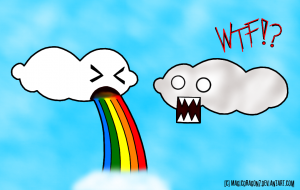I broke free from fear-based anxiety a long time ago. But I still have episodes of anxiety. We all do, and it’s usually when we have trouble sorting through our emotions. To get a better handle on it, I’ve been trying to label the different kinds of anxiousness based on the colors of a rainbow.
I decided to use the first five colors of Newton’s primary color system because if I broke this down by all seven colors, I’d be stretching things. Understand that this isn’t a scientific breakdown; it’s simply how I’ve learned to process what I feel.
- Red. This is the worst of the worst, the type of anxiety that makes you feel like you’re at death’s door. I used to suffer from this one all the time: a cold sweat breaking out on my forehead, my heart pounding so violently that I thought it would break bones, my feet tingling and a constant feeling of having to throw up. Fear is the trigger for this one, the kind of fear that made me not want to go places, take risks and live life in general. For me, Prozac has been a very effective weapon against red anxiety, as has my faith.
- Orange. Fear plays a big role in this anxiety as well, but unlike red, orange is usually rooted in something stressful that is really happening in your life. You could be fighting a serious medical issue and worrying about losing the fight. You could be having financial trouble that results in routine stress but the anxiety magnifies it to monstrous proportions. I’ve had both varieties, with the disease taking the form of Crohn’s Disease and excrutiating back pain. Medication has helped here, too, but therapy to sort reality from a runaway imagination was key.
- Yellow. This anxiety is usually triggered by a lot of sustained stress at work or home. Maybe your marriage has hit a rough patch or your job is riding on the success or failure of a huge project. To get through it, your body pumps more adrenaline than you need, and you get the overwhelmed feeling that keeps you from seeing the order of work items and their level of completion. The news business is a perfect place to experience this because you face daily deadlines and a tongue lashing from your bosses if a competitor gets a big story instead of you. I don’t experience that today, but when I worked for newspapers, this yellow anxiety was always with me. Remedies here include therapy, medicine, a heart-to-heart talk with the boss and, if necessary, a job or even a career change.
- Green. This anxiety appears when the less-frequent stresses spark up. Yesterday was a perfect example in my world: I was already ramped up from spending the previous evening at the hospital holding vigil while my father faced emergency surgery that ultimately didn’t happen. The plumber was coming to install a new dishwasher, and to pound my mind into submission, I went on a chore spree. Then my cell phone died for good, and I had to spend the afternoon replacing it. The latter two events are problems we’re lucky to have, since the alternative is being too broke to afford these things. But it sent the day on a trajectory I hadn’t anticipated. The only cure for this one right now is to reach the end of the day and go to bed.
- Blue. This is a small, sustained level of anxiety so slight that you usually don’t see it for what it is. It’s generally a byproduct of depression. In my case, blue anxiety shows itself in the winter, when a lack of daylight sends me into blue moods. Last winter I started taking Wellbutrin to help the Prozac work better when I’m in this state, and it helped. But what helps me the most is activity. Writing helps a lot and, this winter, I’m thinking the guitar my family got me for my birthday will be a lifesaver.
Whatever level of anxiety you have, none of it has to be permanent. You simply have to choose to do something about it and ask those around you to help you stick to whatever you go with. Without Erin and the kids, I’m pretty sure I’d still be hiding under a rock somewhere.


I have the ‘knotted brain’ level of anxiety at times.
When that hits, I never thought to call it out as a color.
Based on your chart, it’s yellow.
Thanks for sharing.
Thank you for sharing this. When I was in counseling, I used to categorize my anxiety on a number scale, but it was based solely on how I felt rather than truly categorizing it based on what caused it or what was happening. I like the idea of using the colors as you have. I think it could be much more effective. I hope you don’t mind if I steal your idea for my own use.
I have to hospital overnight for the stess test and they could not find anything they said it is anxiety how do I beat it
i have varying degrees of social anxiety all the time, so usually i’m blue-green